Bell Ringers for 6th Grade Language Arts Rl 64
7 Easy and Constructive Bong Ringers to Commencement Your ELA Class
Bell ringers! Likewise normally referred to as course starters, do nows, and warm ups, bong ringers are meaningful activities students consummate when they walk in the door. Students can begin working on bell ringers before the bell even rings! And, they continue working until you are ready to start the lesson.
Bong ringers can benefit our middle and high school students in many ways. If you are searching for ways to spice up your current approach or fix to get started with bell ringers when you haven't used them before, keep reading! I have you covered.

BENEFITS of Bong RINGERS
Arrangement
I first began incorporating bell ringers when the start of class fabricated my head want to explode. Answering student questions while trying to monitor what everyone else was doing was frustrating and an inefficient use of course time. I needed organization and purpose.
Bell ringers can help students get focused right away. They are a classroom routine that provides stability and predictability. When students know what to exercise when they enter the room, they can get calm and outset being productive.
In society for bong ringers to be as organized every bit possible, I recommend training students at the commencement of the yr… where they can notice the task for the day? Your white board? Smart board? Be consistent about having the task upwardly when students enter the room, and this will provide for a smoother kickoff to grade (which actually results in a more fluid classroom feel overall, start to finish).
Bong ringers don't just help with student system! They tin can also help teachers have a breath and go in the right mindset to begin working with the next group of students. Bell ringers provide a few minutes to take attendance, confer with readers, respond to pressing emails, or walk around the room to provide support.
Preview
Bell ringers permit us to preview new content. For instance, if yous are going to begin a new story, why not project several images on the board and inquire students to make a prediction about the theme of the new story based on what they can infer from the images?
Getting set up to begin an essay? Review the importance of the writing process, citation skills, or comma rules.
Review
Class starters besides provide a convenient opportunity to spiral review. We tin use whatsoever blazon of chore or question to continually provide additional practise for cadre standards. Learning judgement types? Project a sentence on the board, and enquire students to identify the parts of speech communication. Then, have them justify the punctuation in the sentence. Why does the author apply this punctuation? How do the parts of the sentence and the punctuation impact the flow?
Example: Rainbows (noun) are (linking verb) beautiful (adjective); I (pronoun) desire (verb) one (pronoun). Students may betoken out that this sentence is choppy. Why? It's short, consisting of two unproblematic sentences joined with a semicolon. The author may have washed this for clarity, but many would find this sentence boring.
The next day, students tin come back to this same sentence and revise it to make it more than fluid! Have them contain any grammatical element(due south) you are working on at the time.
Example: Rainbows glow proudly in the heaven afterwards a night and moody storm. It may seem odd, but I want to bear upon one. Here, I've added some description, phrases, and even personification. This judgement pairing flows more smoothly and has some personality.
Bong RINGER APPROACHES
To Be Consistent or to Mix it Upward?
Some teachers choose to be consistent and use the same blazon of bell ringer every twenty-four hours. I've done this two ways. For one, I have used 10 minutes of contained reading equally the common denominator at the beginning of class. This is my favorite! Still, I still discover that I often follow up this 10 minutes of reading with a different blazon of "bell ringer" job that is more directed at an ELA skill. (more on this in a minute)
I've also started every period consistently with a vocabulary discussion of the twenty-four hour period and corresponding action. My students accept loved every minute of this give-and-take work, and I am passionate nigh showing them the value of language.
Assessing
We have to be careful almost "grading" bell ringer work. English teachers have enough on their plates to "grade" without feeling the need to assign points to bell ringers. If we are only doing it for accountability'due south sake, we may just desire to reconsider the type of work nosotros are doing as bong ringers.
I use bell ringer responses to get an idea of where my students are and what pedagogy they however demand, but I don't often enter points for their piece of work. This mindset shift has developed slowly, merely at present I view bell ringers as practice opportunities that inform my teaching.
If yous operate in a standards-based system, you could utilize bell ringers as evidence of proficiency.
BELL RINGER IDEAS
So now! Let's explore seven bell ringer ideas that are like shooting fish in a barrel to implement and effective for students.
Disclaimer: I don't love packets, and then these ideas are non digitally or physically combined and neatly stapled together for the whole year. They don't all expect the aforementioned or print neatly for binder use. For me, bell ringers are a routine, but diversity inside them (both in terms of appearance and use) adds plenty intrigue that students don't tire of them…and neither practice I! Plus, flexility is freeing.
You can mix and lucifer these ideas to your heart'due south delight. (Think, I always brainstorm with 10 minutes of contained reading. These 7 ideas tin can follow or precede your contained reading time, if you incorporate it also.)

Students enjoy learning new words they will see in reading or that they tin employ while writing. Bell ringers are the perfect opportunity to expand our word banks! Observe more details about the word-a-24-hour interval units my students love here.
1) VOCABUALRY
Students secretly love adding fun new words to their vocabulary bank. When I first began using vocabulary bell ringers, I was shocked past how interested students were in the words. Their sentences were rich, they were engaged in finding synonyms, antonyms, and drawing pictures. And, they began using the words in writing…and even telling me when they came across their words while reading!
Equally a bell ringer, I typically innovate the give-and-take in context. Students practice making inferences most what the give-and-take means, using reference materials to verify definitions, and making connections to the discussion. They even complete a quick discussion wall activity as a visual reminder of our growing word bank.
This approach is for you lot IF …y'all truly want students to learn new words instead of memorizing them.
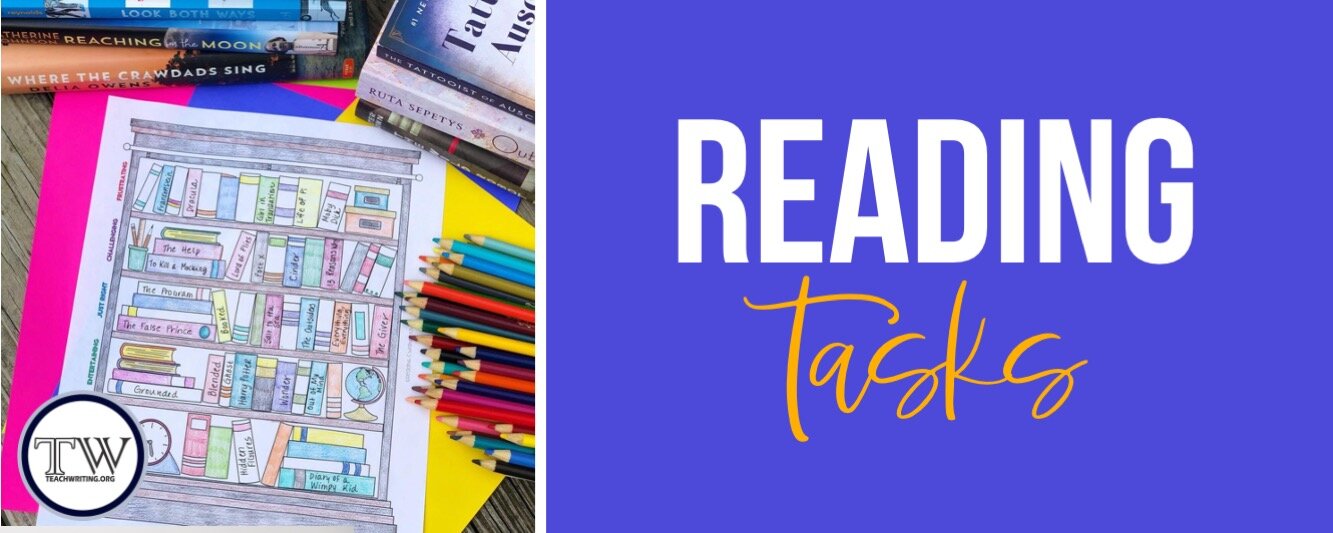
Allowing students fourth dimension to record what they've read, share their reading, or write almost books is a cute way to begin a class period. Observe this reading ladder hither. It's keen for digital and print ELA notebooks.
2) READING UPDATES
Later students read for 10 minutes, it is helpful to give them a few minutes to practice a number of different tasks that complement independent reading. Consider…
Monday: Hash out (informally with whole course, pocket-sized groups, or elbow partners)
Tuesday: Update reading ladder
Wed: Share book recommendations
Th: Share your favorite passage!
Friday: Reading sprints
This approach is for you IF …you feel like there's never enough time to do the "other things" that enhance independent reading.
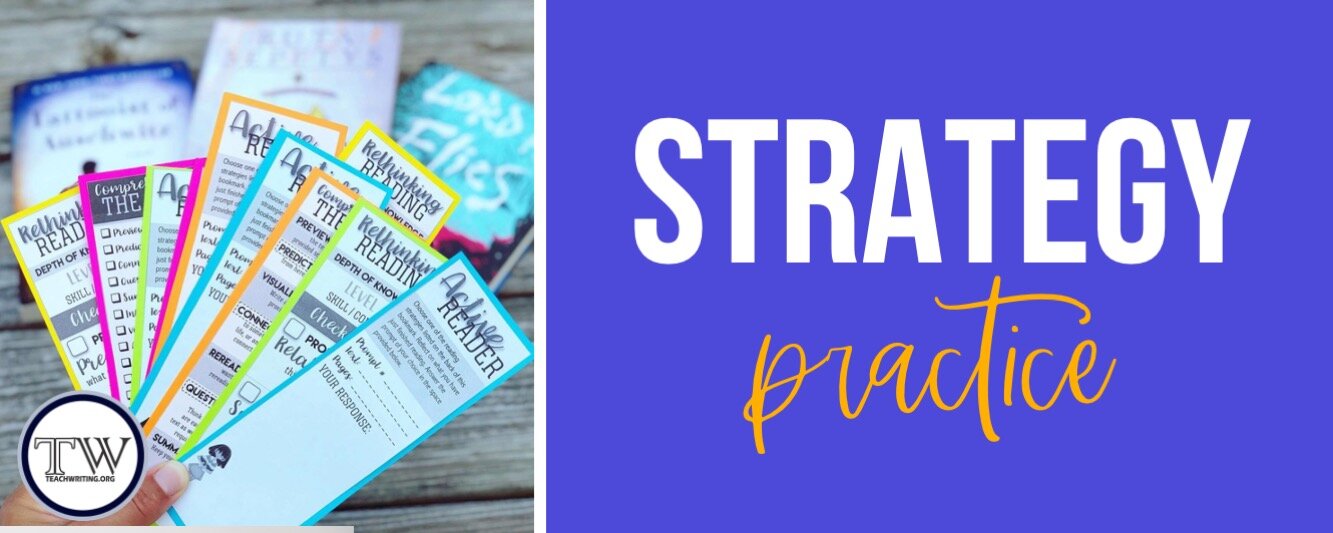
Choose each day of the week to highlight a unlike type of reading do! These differentiated bookmarks allow for choice and varying degrees of depth of knowledge.
3) READING STRATEGY Exercise
I don't like to tie reading assignments straight to pick reading. Making contained reading feel like in that location are strings attached de-motivates readers. However, nosotros can use reading strategy practice in a non-invasive style with bell-ringers. Asking a variety of interesting questions that don't require essay responses, diorama building, or busy work vibes can raise our agreement of any slice of literature.
To practise reading skills, I've used…
-
differentiated bookmarks
-
comprehension task cards
-
graphic organizers
-
discussion prompts
The common denominator with nearly of these practice tasks is that students have choices. They can select the skill they want to work on or the question they want to respond, which increases motivation.
Make these quick! Students tin can discuss their answers with an elbow partner or enter their reply into a simple Google Course. Don't forget to laminate bookmarks and task cards so yous tin reuse them over and over.
This approach is for y'all IF …you value providing selection and want students to accept more opportunities to intentionally process what they are reading.
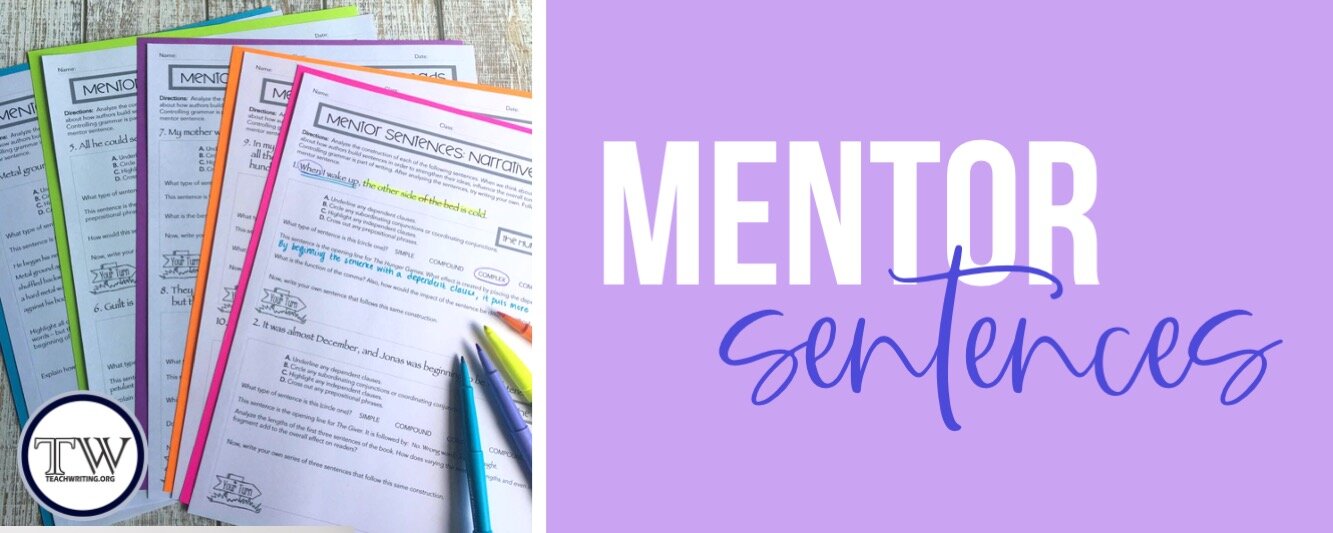
Mentor sentences from YA lit non just allow for language spiral review…but also provide sneak peeks of loftier-interest books. Clarify ane per twenty-four hour period!
4) MENTOR SENTENCES
"The river sounds nice this evening, tripping over stones in the banking concern as information technology lulls me to sleep."
I'll apply this line from the young adult novel Carmine Queen to explain how we can use mentor sentences as bell ringers. Project the quote on the board, make it accessible digitally, or impress information technology on paper. Then, pair it with thought-provoking questions for students to ponder.
For instance:
-
What do you notice? What stands out?
The author describes the river as tripping over stones. I've never thought to describe it that style.
-
Describe the mood and tone of this line (as it appears in isolation or in context)?
The mood seems peaceful and lethargic. The author's serene voice draws attention to how tired the grapheme is.
-
Specifically, what stylistic choices (grammer, figurative language, punctuation, etc) does the author make that create an effect on the reader?
This judgement consists of a simple sentence, a comma, a participle phrase, a prepositional phrase, and a dependent clause. Nice is an understated word, but the author follows the word nice with an unexpected description of the river. Instead of describing its sound, she paints a picture show of the river tripping (personification) over the stones.
-
Now, write your ain sentence that follows this pattern!
The music is loud today, knocking on my walls until my parents whisper, "hush."
Mentor sentences are a quick and effective style to innovate the beauty of writing with short awarding opportunities. (Plus, we can sneak in some high-interest book plugs!) Use sentences from texts the whole class has read or from those they have not.
This approach is for you lot IF …you are always and forever searching for ways to integrate and spiral ELA skills.
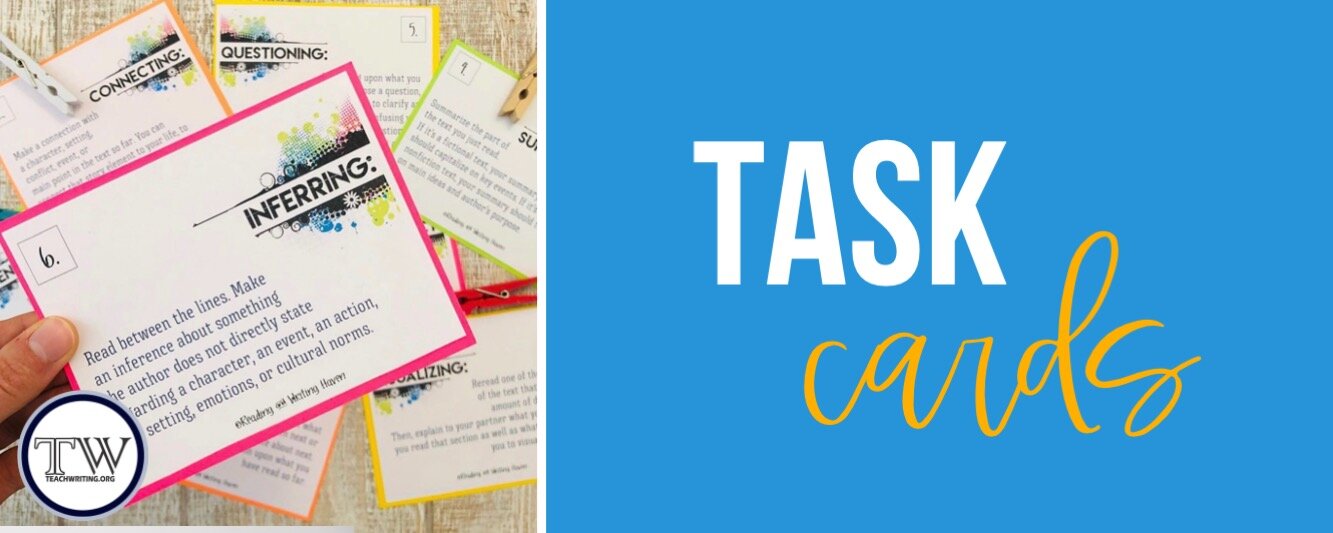
Task cards are convenient for pretty much…everything! (including bell ringers) These reading comprehension cards can easily be used to review a whole-class text, modest group read, or fifty-fifty an contained book.
5) TASK CARDS
When students walk in the room, direct them to take a bill of fare from a table or pull up a digital task card. The task carte does the rest of the work! I like using task cards for…
-
discussion prompts
-
concept reviews
-
editing goals
-
grammar practice
-
vocabulary associations
…and more! You tin find a collection of my job cards for a multifariousness of learning goals here. After completing their job menu, students can grab another or share their learning with classmates.
Mix it up! If you are wanting to incorporate a little movement right abroad, hang the task cards around the room or in the hallway and then students are continuing every bit they retrieve, walking from ane task to another. (This uncomplicated format is surprisingly engaging…you'll but want to brand sure to train students not to crowd effectually the same carte!)
This approach is for yous IF …you beloved student-driven learning, collaboration, differentiation, and movement.

Jamboard templates (likewise compatible with PowerPoint or Google Slides) allow for spiral review of writing skills.
six) JAMBOARDS
Bell ringers should never be a waste of time. We tin maximize every precious minute we take with students by using bell ringer time to accomplish whatsoever number of tasks.
-
peer editing
-
community building
-
language skills
-
writing about reading
-
note taking
You name it! In my building, course periods are 44 minutes. If you ever feel similar at that place just isn't enough fourth dimension in the world to accomplish all the things, try Jamboard! Information technology's is a fun, interactive mode to continue students engaged from the moment the bong rings. Jamboard is a Google tool that works beautifully both in person and online. Students can collaborate in groups or work independently while easily viewing one some other'south boards.
Save time when lesson planning past having a variety of Jamboard templates on mitt.
I've written more in depth about Jamboard'south usefulness, specifically with teaching writing, in this weblog mail.
This approach is for y'all IF …you lot like the idea of quick activities students can complete online that highlight a variety of language skills.
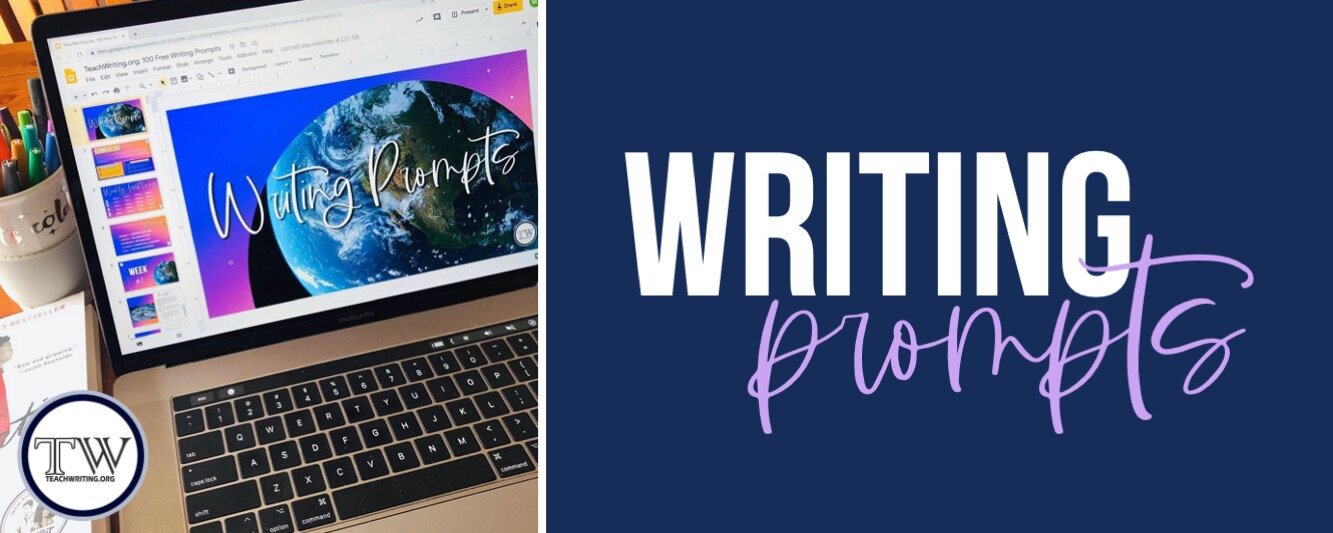
7) WRITING PROMPTS
Writing prompts can inspire students. They can exist a springboard for form conversations and a powerful way to integrate vocabulary, reading, writing, and grammar. The collaborators at Teachwriting.org have compiled 100 writing prompts for y'all to draw from throughout the school year. Yous can grab them for gratuitous right hither!
Upon download, you lot'll discover a wide variety of prompts, including narrative, informative, argumentative, creative writing, and mentor sentence topics. In that location truly is no shortage of means students can use these prompts. As they write, you accept a convenient artery to confer with students!
This approach is for you lot IF …you want your students to write every day.
When it comes to bell ringers, almost anything goes. I promise these 7 ideas will serve as a creative springboard for your planning purposes. Finding a routine that helps students become settled, y'all to become organized, and learning to exist meaningful is somewhat of a balancing act. Just, one time you find your groove, you'll be doing a happy dance all year long.
SPOTLIGHT Resources:
Older students Dearest these vocabulary bell ringers! Building these in throughout the yr provides opportunities for deep conversations about linguistic communication, context clue piece of work, then much more.

Nigh THE Author

Melissa is the author of Reading and Writing Haven and a collaborative blogger on Teachwriting.org.
A eye and high school English teacher for over a decade now turned instructional coach, Melissa is an avid reader and writer, and she loves sharing ideas and collaborating with young man educators. Melissa use her degrees in English, Curriculum & Teaching, and Reading every bit well as her Reading Specialist certification to ponder today's educational problems while developing resources to help teachers, students, and parents make learning more relevant, meaningful, and engaging.
Visit Melissa on Instagram,Facebook, or Twitter for English instructor camaraderie and applied, engaging teaching ideas.

Source: https://www.teachwriting.org/612th/2021/6/10/8-easy-amp-effective-bell-ringers-to-start-your-ela-class
0 Response to "Bell Ringers for 6th Grade Language Arts Rl 64"
Post a Comment